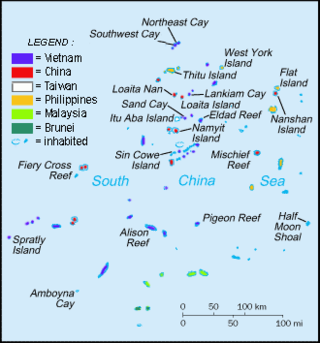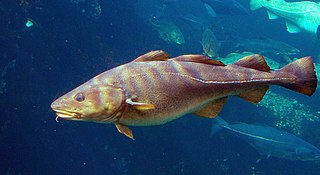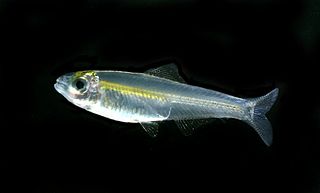
The Spratly Islands are a disputed archipelago in the South China Sea. Composed of islands, islets, cays, and more than 100 reefs, sometimes grouped in submerged old atolls, the archipelago lies off the coasts of the Philippines, Malaysia, and southern Vietnam. Named after the 19th-century British whaling captain Richard Spratly who sighted Spratly Island in 1843, the islands contain less than 2 km2 of naturally occurring land area, which is spread over an area of more than 425,000 km2 (164,000 sq mi).

Cod is the common name for the demersal fish genus Gadus, belonging to the family Gadidae. Cod is also used as part of the common name for a number of other fish species, and one species that belongs to genus Gadus is commonly not called cod.

Sprat is the common name applied to a group of forage fish belonging to the genus Sprattus in the family Clupeidae. The term also is applied to a number of other small sprat-like forage fish. Like most forage fishes, sprats are highly active, small, oily fish. They travel in large schools with other fish and swim continuously throughout the day.

The eastern bettong, also known as the southern or Tasmanian bettong, is a small, hopping, rat-like mammal native to grassy forests of southeastern Australia and Tasmania. A member of the rat-kangaroo family (Potoroidae), it is active at night and feeds on fungi and plant roots. Like most marsupials, it carries its young in a pouch. The eastern bettong is under pressure by introduced predators and habitat loss. The subspecies on mainland Australia is extinct, but populations of the Tasmanian subspecies have been reintroduced there.

The European sprat, also known as bristling, brisling, garvie, garvock, Russian sardine, russlet, skipper or whitebait, is a species of small marine fish in the herring family Clupeidae. Found in European waters, it has silver grey scales and white-grey flesh. Specific seas in which the species occurs include the Irish Sea, Black Sea, Baltic Sea and Sea of the Hebrides. The fish is the subject of fisheries, particularly in Scandinavia, and is made into fish meal, as well as being used for human consumption. When used for food it can be canned, salted, breaded, fried, boiled, grilled, baked, deep fried, marinated, broiled, and smoked.

The New Zealand blueback sprat is a herring-like, forage fish of the family Clupeidae found in the waters around New Zealand, between latitudes 37° S and 48° S, and longitude 166° E and 180° E, to depths of up to 50 m. It belongs to the genus Sprattus, a small oily fish usually known by their common name, sprats. Its length is up to 12 cm.
The New Zealand sprat is a herring-like, marine fish in the family Clupeidae found in the subtropical southwest Pacific Ocean endemic to New Zealand. It belongs to a genus Sprattus of small oily fish, usually known by their common name, sprats.

Sardinella is a genus of fish in the family Dorosomatidae found in the Atlantic, Indian and Pacific Ocean. They are abundant in warmer waters of the tropical and subtropical oceans. Adults are generally coastal, schooling, marine fish but juveniles are often found in lagoons and estuaries. These species are distinguished by their ranges and by specific body features, but they are often confused with one another. Fish of the genus have seven to 14 striped markings along the scales of the top of the head. The paddle-shaped supramaxilla bones are characteristic; they separate Sardinella from other genera and their shapes help distinguish species. They have paired predorsal scales and enlarged fin rays.

Namyit Island, also known as Vietnamese: Đảo Nam Yết; Binago Island ; Mandarin Chinese: 鴻庥島/鸿庥岛; pinyin: Hóngxiū Dǎo, is the third-largest island on Tizard Bank in the northwest of the Spratly Islands in South China Sea. With an area of 5.3 hectares, it is the twelfth-largest naturally-occurring Spratly island, and the fifth-largest among the Vietnamese-administered islands. The island is also claimed by China (PRC), the Philippines, and Taiwan (ROC).

Hyperlophus is a genus of sprat belonging to the herring family Clupeidae. They are endemic to the waters around Australia. There are currently two species recognized in the genus.

Clupeoides is a genus of sprats that occur in rivers in Southeast Asia. There are currently four recognized species in the genus.

Clupeonella is a genus of fish in the family Clupeidae. They are widespread in the fresh and brackish waters of the Caspian Sea and Black drainages.

Zacco is a genus of small ray-finned fishes in the family Cyprinidae. They are found in freshwater habitats in China and northern Vietnam. The generic name Zacco derives from the Japanese Zako雑魚.

Clupeichthys is a genus of sprats, herring-like fishes, that occur in rivers in Southeast Asia. There are currently four recognized species in the genus.

Corica is a small genus of sprats that occur in rivers in South Asia and Southeast Asia. Two described species are placed in the genus.
Nannothrissa is a genus of very small fish in the herring family, Dorosomatidae, endemic to the Congo River system in Africa. There are currently only two recognized species
Platanichthys platana, the Rio Plata sprat, is a very small species of fish belonging to the family, Dorosomatidae. It is endemic to South America. It is the only species in its genus.
Ramnogaster is a small genus of sprats found only in South America. Two species are placed in this genus:

Rhinosardinia is a small genus of sprats restricted to the rivers of South America. There are currently only two described species in the genus.

The Alosidae, or the shads, are a family of clupeiform fishes. The family currently comprises four genera worldwide, and about 34 species.
















